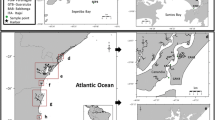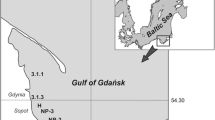Abstract
Marine sediments and gastropod, Thais clavigera, were collected from industrialized areas and major harbors in Korea, to assess contamination sources and ecological risk to marine organisms by butyltin compounds such as tributyltin (TBT). TBT concentrations in sediments ranged from <LOD to 5372 ng Sn/g dry weight, and were comparable to or higher than concentrations in big harbors of other countries. The highest TBT concentrations were found in sediments close to shipyards in surveyed bays, suggesting that shipyard activities are a major contamination source of butyltins in Korean coastal waters. About half of the sediments showed potential risk of exceeding the guidelines and values proposed in in vivo studies. The occurrence of imposex in T. clavigera was 100% at all locations, indicating that the present levels of TBT contamination in industrialized bays in Korea are at concentrations reported to induce toxic effects on marine organisms, despite TBT’s having been legally banned in Korea.




Similar content being viewed by others
References
Amouroux D, Tessier E, Donard OFX (2000) Volatilization of organotin compounds from estuarine and coastal environments. Environ Sci Technol 34:988–995. doi:10.1021/es981025p
Berto D, Giani M, Boscolo R, Covelli S, Giovanardi O, Massironi M, Grassia L (2007) Organotins (TBT and DBT) in water, sediments, and gastropods of the southern Venice lagoon (Italy). Mar Pollut Bull 55:425–435. doi:10.1016/j.marpolbul.2007.09.005
Bhosle NB, Garg A, Harji R, Jadhav S, Sawant SS, Krishnamurthy V, Anil C (2006) Butyltins in the sediments of Kochi and Mumbai harbours, west coast of India. Environ Int 32:252–258. doi:10.1016/j.envint.2005.08.020
Biselli S, Bester K, Huhnerfuss H, Fent K (2000) Concentrations of the antifouling compound Irgarol 1051 and of organotins in water and sediments of German North and Baltic Sea marinas. Mar Pollut Bull 40:233–243. doi:10.1016/S0025-326X(99)00177-0
Blackmore G (2000) Imposex in Thais clavigera (neogastropoda) as an indicator of TBT (tributyltin) biovailability in coastal waters of Hong Kong. J Moll Stud 66:1–8. doi:10.1093/mollus/66.1.1
Burton ED, Phillips IR, Hawker DW (2004) Sorption and desorption behavior of tributyltin with natural sediments. Environ Sci Technol 38:6694–6700. doi:10.1021/es049291s
Burton ED, Phillips IR, Hawker DW (2005) In-situ partitioning of butyltin compounds in estuarine sediments. Chemosphere 59:585–592. doi:10.1016/j.chemosphere.2004.10.067
Burton ED, Phillips IR, Hawker DW (2006) Tributyltin partitioning in sediments: effect of aging. Chemosphere 63:73–81. doi:10.1016/j.chemosphere.2005.07.048
Chan KM, Leung KMY, Cheung KC, Wong MH, Qiu JW (2008) Seasonal changes in imposex and tissue burden of butyltin compounds in Thais clavigera populations along the coastal area of Mirs Bay, China. Mar Pollut Bull 57:645–651. doi:10.1016/j.marpolbul.2008.02040
Choi M, Choi HG, Kim SS, Moon HB (2005) Evaluation of sewage-derived organic matter using fecal sterols in the sediments from Ulsan Bay and adjacent areas. J Korean Environ Sci 41:23–32 (in Korean)
Choi M, Choi HG, Moon HB, Kim GY (2008) Spatial and temporal distribution of tributyltin (TBT) in seawater, sediments and bivalves from coastal areas of Korea during 2001–2005. Environ Monitor Assess. doi:10.1007/s10661-008-0271-0
Devos C, Vliegen M, Willaert B, David F, Moens L, Sandra P (2005) Automated head space-solid-phase microextraction-retention time locked-isotope dilution gas chromatography–mass spectrometry for the analysis of organotin compounds in water and sediment samples. J Chromatogr A 1079:408–414. doi:10.1016/j.chroma.2004.12.020
Diez S, Lacorte S, Viana P, Barcel D, Bayona JM (2005) Survey of organotin compounds in rivers and coastal environments in Portugal 1999–2000. Environ Pollut 136:525–536. doi:10.1016/j.envpol.2004.12.011
Diez S, Jover E, Albaiges J, Bayona JM (2006) Occurrence and degradation of butyltins and wastewater marker compounds in sediments from Barcelona harbor, Spain. Environ Int 32:858–865. doi:10.1016/j.envint.2006.05.004
Evans SM, Kerrigan E, Palmer N (2000) Causes of imposex in the dogwhelk Nucella lapillus (L.) and its use as a biological indicator of tributyltin contamination. Mar Pollut Bull 40:212–219. doi:10.1016/S0025-326X(99)00210-6
Fernandez MA, a Rebellovagener A, Limaverde AM, Scofield AL, Pinheiro FM, Rodrigues E (2005) Imposex and surface sediments speciation: a combined approach to evaluate organotin contamination in Guanabara Bay, Rio de Janeiro, Brazil. Mar Environ Res 59:435–452. doi:10.1016/j.marenvres.2004.07.001
Gibbs PE, Bryan GW, Pascoe PL, Burt GR (1987) The use of dogwhelk, Nucella lapillus, as an indicator of tributyltin (TBT) contamination. J Mar Biol Assoc UK 67:507–523
Harino H, Fukushima M, Yamamoto Y, Kawai S, Miyazaki N (1998) Organotin compounds in water, sediments, and biological samples from the port of Osaka, Japan. Arch Environ Contam Toxicol 35:558–564. doi:10.1007/s002449900416
Hong SH, Yim UH, Shim WJ, Oh JR (2005) Congener-specific survey for polychlorinated biphenyls in sediments of industrialized bays in Korea: regional characteristics and pollution sources. Environ Sci Technol 39:7380–7388. doi:10.1021/es050397c
Horiguchi T, Shiraishi H, Shimizu M, Morita M (1994) Imposex and organotin compounds in Thais clavigera and T. bronni in Japan. J Mar Biol Assoc UK 74:651–669
Hung TC, Hsu WK, Mang PJ, Chuang A (2001) Organotins and imposex in the rock shell, Thais clavigera, from oyster mariculture areas in Taiwan. Environ Pollut 112:145–152. doi:10.1016/S0269-7491(00)00123-8
Kan-Atirekrap S, Tanabe S, Sanguansin J (1997) Contamination by butyltin compounds in sediments from Thailand. Mar Pollut Bull 34:894–899. doi:10.1016/S0025-326X(97)00053-2
Khim JS, Lee KT, Kannan K, Villeneuve DL, Gisey JP, Koh CH (2001) Trace organic contaminants in sediment and water from Ulsan Bay and its vicinity, Korea. Arch Environ Contam Toxicol 40:141–150. doi:10.1007/s002440010157
KSA (Korea Shipbuilders’ Association) (2007) Korean shipbuilding statistics. KSA, Seoul (in Korean)
Langstone WJ, Burt GR (1991) Bioavailability and effects of sediment-bound TBT in deposit-feeding clams, Sorbicularia plana. Mar Environ Res 32:61–77. doi:10.1016/0141-1136(91)90034-6
Leung KMY, Kwong RPY, Ng WC, Horiguchi T, Qiu JW, Yang R, Song M, Jiang G, Zheng GJ, Lam PKS (2006) Ecological risk assessments of endocrine disrupting organotin compounds using marine neogastropods in Hong Kong. Chemosphere 65:922–938. doi:10.1016/j.chemosphere.2006.03.048
Matthiessen P, Thain JE (1989) A method for studying the impact of polluted marine sediments on intertidal colonising organisms; tests with diesel-based drilling mud and tributyltin anti-fouling paint. Hydrobiology 188(189):477–485
MOMAF (Ministry of Maritime Affairs, Fisheries) (2002) Domestic plans for anti-fouling system convention in the International Maritime Organization (IMO). MOMAF, Seoul (in Korean)
MOMAF (Ministry of Maritime Affairs, Fisheries) (2004) Shipping statistics in Korea. MOMAF, Seoul (in Korean)
Moon HB, Kannan K, Choi M, Choi HG (2007) Polybrominated diphenyl ethers (PBDEs) in marine sediments from industrialized bays of Korea. Mar Pollut Bull 54:1402–1412. doi:10.1016/j.marpolbul.2007.05.024
Moon HB, Choi HG, Lee PY, Ok G (2008) Congener-specific characterization and sources of polychlorinated dibenzo-p-dioxins, dibenzofurans and dioxin-like polychlorinated biphenyls in marine sediments from industrialized bays of Korea. Environ Toxicol Chem 27:323–333. doi:10.1897/07-337R.1
Nias DJ, McKillup SC, Edyvane KS (1993) Imposex in Lepsiella vinosa from Southern Australia. Mar Pollut Bull 26:380–384. doi:10.1016/0025-326X(93)90185-M
O’Connor TP, Lauenstein GG (2006) Trends in chemical concentrations in mussels and oysters collected along the US coast: update to 2003. Mar Environ Res 62:261–285. doi:10.1016/j.marenvres.2006.04.067
Page DS, Ozbal CC, Lanphear ME (1996) Concentration of butyltin species in sediments associated with shipyard activity. Environ Pollut 91:237–243. doi:10.1016/0269-7491(95)00046-1
Regoli L, Chan HM, de Lafontaine Y, Mikaelian I (2001) Organotins in zebra mussels (Dreissena polymorpha) and sediments of the Quebec City Harbor area of the St. Lawrence River. Aquat Toxicol 53:115–126. doi:10.1016/S0166-445X(00)00174-0
Ruiz JM, Bachelet G, Caumette P, Donard OFX (1996) Three decades of tributyltin in the coastal environment with emphasis on Arcachon Bay, France. Environ Pollut 93:195–203. doi:10.1016/0269-7491(96)00029-2
Shim WJ, Oh JR, Kahng SH, Shim JH, Lee SH (1998) Accumulation of tributyl- and triphenyltin compounds in Pacific oyster, Crassostrea gigas, from the Chinhae Bay System, Korea. Arch Environ Contam Toxicol 3:105–114
Shim WJ, Oh JR, Kahng SH, Shim JH, Lee SH (1999) Horizontal distribution of butyltins in surface sediments from an enclosed bay system, Korea. Environ Pollut 106:351–357. doi:10.1016/S0269-7491(99)00109-8
Shim WJ, Kahng SH, Hong SH, Kim NS, Kim SK, Shim JH (2000) Imposex in the rock shell, Thais clavigera, as evidence of organotin contamination in the marine environment of Korea. Mar Environ Res 49:435–451. doi:10.1016/S0141-1136(99)00084-7
Shim WJ, Hong SH, Kim NS, Yim UH, Li D, Oh JR (2005) Assessment of butyl- and phenyltin pollution in the coastal environment of Korea using mussels and oysters. Mar Pollut Bull 51:922–931. doi:10.1016/j.marpolbul.2005.07.015
Thomas KV, Fileman TW, Readman JW, Waldock MJ (2001) Antifouling paint booster biocides in the UK coastal environment and potential risks of biological effects. Mar Pollut Bull 42:677–688. doi:10.1016/S0025-326X(00)00216-2
USEPA (1996) Recommendations for screening values for tributyltins in sediments at superfund sites in Puget Sound, Washington. EPA ECL-111. U.S. Environment Protection Agency, Seattle, WA
USEPA (2003) Ambient aquatic life water quality criteria for tributyltin (TBT)—final. Heath and Ecological Criteria Division. U.S. Environmental Protection Agency, Washington, DC
Wade TL, Sweet ST, Quinn JG, Cairns RW, King JW (2004) Tributyltin in environmental samples from the former Derecktor Shipyard, Coddington Cove, Newport RI. Environ Pollut 129:315–320. doi:10.1016/j.envpol.2003.10.016
Acknowledgments
This work was funded by a grant from the National Fisheries Research and Development Institute (NFRDI; RP-2008-ME-35), Korea. We thank Dr. Hyeon-Seo Cho, Chonnam National University, for measuring imposex levels in T. clavigera.
Author information
Authors and Affiliations
Corresponding author
Rights and permissions
About this article
Cite this article
Choi, M., Moon, HB., Yu, J. et al. Butyltin Contamination in Industrialized Bays Associated with Intensive Marine Activities in Korea. Arch Environ Contam Toxicol 57, 77–85 (2009). https://doi.org/10.1007/s00244-008-9235-1
Received:
Accepted:
Published:
Issue Date:
DOI: https://doi.org/10.1007/s00244-008-9235-1




